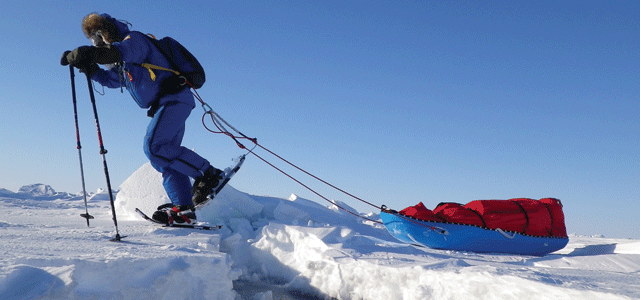Driven to Run
October 31, 2012

In April 2011, Pat Farmer began running from the North Pole to the South. Scott Wegener spoke to him about his 10-month journey.
They’ll say you’re “courageous” or “inspiring” if you’ve battled through a seemingly hopeless situation. But if you’ve created the situation on purpose, you may be labelled “foolhardy” instead.
On the other hand, if you’ve deliberately put yourself in such hopeless circumstances all because you’ve been motivated to help those who are in an even worse predicament than yourself, you’re Pat Farmer.
The Situation
In what must be one of the greatest demonstrations of what the human mind and body are capable of, Sydney-born Farmer ran from the North Pole to the South Pole, to raise funds for the International Red Cross’s clean water projects around the world.
The 21,000-kilometre route was covered in just over 10 months (completed in January this year), at an average of over 65 kilometres a day. At times, Farmer ran up to two and a half marathons a day, which is more than 100 kilometres.
The run was full of adventures, including dangerous animal encounters, armed escorts, weather ranging from -40 to +40 degrees Celsius, breaking world records, being robbed, a flying truck, being urinated on by a cow, being bitten by dogs, a large collection of personal injuries and near-death experiences for Farmer and his tiny crew.
Farmer details the full impact of his expedition in his inspiring journal, Pole to Pole: One Man, 20 Million Steps.
Perhaps what astounded me the most was his struggle to build sponsorship. Simply put, almost no-one thought he’d make the distance, so almost no-one wanted to sponsor him. Farmer sold his house and car to raise the start-up funds to begin the run and simply hoped that enough sponsors would eventually get on board to cover the huge mounting costs.
Farmer attributes the survival of several near-death episodes along the way to smart pre-trip planning, being prepared and also a little divine help. “I’m a big believer that Someone is watching over me,” he says.
In suggesting his guardian angels may have preferred a couch potato to look after rather than follow him halfway around the world, Farmer admits his heavenly “support crew” were “kept on their toes.”
The Man
This isn’t Farmer’s first long distance run. He’s been an ultramarathon (races further than a traditional marathon) runner for many years. Some of his efforts include running across the US, around Australia and from the northern tip to the southern end of Australia. In doing so, he’s not only set world records but raised millions of dollars for good causes—not bad for someone who was “not good at school sports.”
“My legs are my form of communication,” Farmer says while walking and talking to me. “While I have the ability to put one foot in front of the other, I’ll try and use them as my way of communicating messages of support to worthwhile causes. I try to capture the imagination with what I do.”
If you’ll excuse the pun, poles apart from Farmer’s epic physical feats was his near decade-long stint sitting in Australia’s Federal Parliament. This was a time Farmer found somewhat frustrating.
“I wanted to actually make a diff-erence, not simply sit in meetings talking about changing lives,” he says. Even so, Farmer still had some highlights from his parliamentarian days.
“I did achieve some good things, even though the world’s media might consider them minor. From helping a lady who hadn’t eaten anything solid for two years get a set of dentures, to helping someone with an immigration issue get his parents out here for Christmas, and building an $80 million medical school. These are extremes of the spectrum, but to each of the people involved in the situations, very important.”
A few months after Farmer’s Pole to Pole run, he was awarded the 2012 Australian Geographic Society’s Adventurer of the Year. Farmer was also named the Australian Achiever of the Year in 2000.
Despite his amazing achievements, which grant him unchallengeable bragging rights, he is rather humble about his deeds. Farmer prefers to draw attention to the cause he ran for and encourage others to believe in themselves and what they can achieve if they put their mind to it.
The Mind
Farmer admits he isn’t the world’s greatest runner, but says the strongest part of his ability to run nonstop, literally from one end of the earth to the other, is the strength of his mind. It is his mind that gives Farmer the willpower and the ability to overcome pain, and even boredom from so many hours out running by himself. It’s also believing in himself and what he’s capable of that helps him to achieve monumental tasks.
“I’d like to think I was an example to everyone that they can achieve anything they want to if they put their mind to it,” he says. “First, you have to get out there and have a go, but second, break it down into bite-sized pieces. Often people are overawed by a project because they don’t just take it one step at a time.”
In the times Farmer hurt most on his run, he would think about the next time he could see “the lights of his life,” his two children, Brooke and Dillon. Farmer has had to raise them without his wife, Lisa, who died unexpectedly at age 34 from heart disease.
Brooke and Dillon’s names were even written on Farmer’s skis, to help motivate him through the horrendous conditions of the Arctic.
The Cause
These days, raising money and awareness for a cause usually involves something quite sedentary, like shaving your head or growing a moustache. For Farmer it was running. He wanted to draw attention to a cause he’d grown passionate about: clean water.
Farmer’s passion for the Red Cross’s clean water projects came after witnessing the real poverty in India, Nepal, Egypt and Peru in 2008 and in the following year, while spending the school holidays with his kids helping an orphanage in Thailand.
“These experiences influenced me profoundly and left me wanting to do something practical to help,” he says. “Specifically, to raise awareness of the poverty that exists in some of the world’s poorest communities and to raise money to build wells and to provide clean sanitary conditions for them.”
Farmer points out how every 15 seconds, a child passes away from a disease caused by lack of safe drinking water, inadequate sanitation or poor hygiene—things we take for granted in Australia and New Zealand.
“In East Timor, a child died before my eyes. In South-east Asia, I saw children covered in needle-stick injuries in a dump; they were trying to break syringes down to sell the metal inside for bottles of water. It was a heartbreaking turning point in my life. I wanted to raise an enormous amount of money for such a cause.”
The Results
Farmer dreamt of inspiring just 50 million of the world’s total population to donate as little as $2 each, and therefore raising a total of $A100 million.
Astoundingly, by the end of his epic run, Farmer raised a mere 0.1 per cent of what he hoped to: $A100,000.
Falling so short of his financial goal, was the perilous run worth the energy? According to Farmer, without doubt.
“We affected a lot of people by what they saw, which you can’t put a value on. For example, the president of the Red Cross in Columbia said they had never received so much positive publicity, even in times of catastrophe, when helping out with mud slides and hurricanes.”
“There was something very positive that came out of this that you can’t get from mail-outs or a news reader saying there’s a worthy cause that needs support. It’s about people actually seeing another human being prepared to hurt and ache for the sake of a good cause. And when they see you out running in torrential rain or searing heat, it impacts people more than a traditional campaign.”
Since returning home, more donations have come in. Wells have already started to be dug and are making a difference in people’s lives.
It’s a cause that led one man to run to the heights of the earth, to help some of the 880 million fellow human beings who live without one of the most basic items we take for granted: clean water.
Pole to Pole: One Man, 20 Million Steps, by Pat Farmer, is published by Allen & Unwin (2012).







